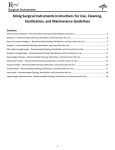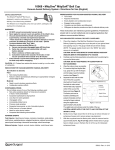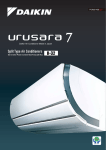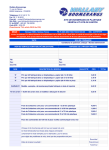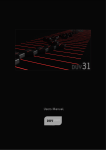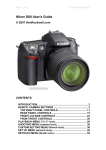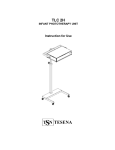Download Home Phototherapy at Children`s Home Healthcare
Transcript
Home Phototherapy at Children’s Home Healthcare INTRODUCTION Your baby has jaundice, a common disorder of newborns caused when the chemical “bilirubin” builds up in the baby's blood, resulting i n a y e l l o w i s h c o l o r t o the skin. Your baby’s physician has ordered phototherapy to treat this condition. Used for many years as the safest and most effective treatment, phototherapy consists simply of shining light onto the skin surfaces of your baby. This light breaks down the excess bilirubin in the skin and lowers the baby's bilirubin back to a safe level. In recent years, phototherapy has moved increasingly from the hospital setting into the home. There are many good reasons for this trend: Portable Home Phototherapy units which are safe and effective are now available; cost of treatment is much less at home; the act of bonding between parents and baby is not interrupted; convenient feeding schedules can be maintained. This instruction booklet should help you become comfortable with caring for your baby while using home phototherapy. If you have any additional questions, please feel free to call Children’s Home Healthcare and ask to speak to one of the home health nurses. Please call 402.734.6741 or 1-800-747-7334 or if you are in the Lincoln area call 402-486-1511 or 1-866-955-8780 any time, 24 hours per day, 7 days per week. Thank you for trusting us to provide home phototherapy for your baby! CHILDREN’S HOME HEALTHCARE WILL PROVIDE: • Phototherapy unit & all necessary supplies. • Instructions on use of the home phototherapy unit. • Instructions on how to care for a baby with jaundice. • Daily visits, if ordered, by a clinician to assess your baby. • 24 hour on-call Children’s Home Healthcare (CHHC) nurse to assist as needed. TYPES of PHOTOTHERAPY UNITS: You will have one of two types of phototherapy lights: either “Belt” Phototherapy (a Wallaby unit or a Bili TX unit), or “Bed” Phototherapy (this is called a PEP or Conventional phototherapy). The decision on which unit your baby will receive is based on your physician's preference. 1. “BELT” Phototherapy: A reflective plastic belt wraps around the chest/stomach of the baby by a cable. The plastic belt has a cover made of hypoallergenic material to make it more comfortable for your baby. This fiber optic unit is very portable and allows you to hold your baby while he/she is receiving phototherapy treatment. • • 2. WALLABY: The Wallaby phototherapy unit weighs about 12 pounds and is 15"x 7"x 7" on size. This unit has 2 light bulbs that alternate during therapy. BILITX: The Bili TX phototherapy unit weighs about 2 to 3 pounds. It is a compactly designed unit with a parent-friendly sling. This unit has Blue LED (light emitting diodes) light source which delivers high irradiance & stable light output. “BED” Phototherapy: The baby lies inside a little bed and there is phototherapy light shining down to him/her. • PEP Unit (or Conventional Unit): Our PEP unit fits into a standard size crib or can be placed on a table top or floor. It measures 25" x 16 1/2" x 20" in size. It has transparent sides so the baby may be observed all times. The baby is placed on the mattress provided in the PEP unit. Children’s Home Healthcare 4156 South 52nd Street Omaha, NE 68117 402.734.6741 ChildrensOmaha.org HOW TO DRESS YOUR BABY: It is important to understand how your phototherapy unit works, and how the baby should be dressed during treatment. A quick guide is listed below: 1. For a baby using only a Wallaby or Bili TX • • • • 2. The Bili TX & Wallaby do not generate heat. Dress your baby OVER the belt as appropriate to maintain normal temperature. Nothing should be placed between baby's skin and belt. You may need to roll an infant T-shirt up high on the chest to be positioned against the baby’s armpits to protect/prevent rubbing of the belt on the armpits. For a baby using a PEP Unit • • • • Dress your baby ONLY in a diaper and the baby will need to wear an eye mask while under the lights. You may use a thin blanket to nestle around the baby for positioning while under lights BUT you must not cover any skin surface as this will prevent the phototherapy light from affecting the skin. When baby is out of lights for feedings, wrap your baby in blankets to maintain his/her temperature. Remove eye mask when baby is out of lights for feedings. PARENTS' RESPONSIBILITIES DURING THERAPY: Two important things you can do while your baby is under phototherapy: 1.) Keep the baby exposed to the phototherapy lights as much as possible; and 2.) feed your baby every two to three hours to ensure your baby does not get dehydrated. Frequent feeds will also enhance bowel movements which is the route by which most of bilirubin will be excreted or removed from the body. 1. 2. 3. 4. 5. Take baby's temperature before feedings when on the PEP unit and four times per day when on the wallaby unit. Record the baby’s wet and dirty diapers. Record the baby’s amounts and frequency of feedings. Record the baby’s amount of time lights are not being used. Document all of the above information on the Parent Daily Record Sheet. CONTACT CHHC CLINICIAN IF: 1. Baby's condition changes such as: • Problems with feeding • Vomiting • Extreme sleepiness • Rashes or skin irritations • Temperature changes 2. Lights are not working properly. Please call 402-734-6741 or 1-800-747-7334 any time, 24 hours per day, 7 days per week and ask for a CHHC nurse on-call. The CHHC nurse on-call will assist you with your concerns. Children’s Home Healthcare 4156 South 52nd Street Omaha, NE 68117 402.734.6741 ChildrensOmaha.org SAFETY MEASURES: Protect equipment from damage 1) Avoid moving the unit as much as possible. 2) Place cords where they cannot be tripped over. 3) Use this equipment with the same precautions of any electrical device; water precautions, no extension cords and use safe electrical outlets. 4) You are responsible for the safe use of this equipment while it is in your home. If you feel uncomfortable with any aspect of its use, call CHHC. For Wallaby 1) Place unit on solid, open area while being used. 2) Do not block fan area. 3) Avoid placing any article on or over unit. 4) Allow unit to cool 10 to 20 minutes before moving to a new area. 5) Turn unit off and unplug unit before changing bulbs (mechanically or manually). 6) If one bulb burns out, the yellow system alert light will flash. Ask the CHHC clinician to change the bulb at the next home visit. 7) If both bulbs burn out, or if unit overheats, the yellow light is solid. You will need to change the light bulbs with the supplies provided. 8) Always keep wallaby on level 2. For Bili TX 1) Use the parent-friendly sling to hold the Bili TX while moving or changing positions. 2) Press and hold the On/Off button to shut the unit off. This two-step process for shutting the unit off is a safety measure to ensure the unit is not accidentally turned off. For PEP Unit 1) Place the PEP unit in the crib, on table, or on the floor avoiding drafts and direct heat. 2) Turn the unit off when baby is out of the unit. 3) Keep the baby’s eye mask on continuously while under the PEP unit lights. 4) With the light on, the temp inside the PEP unit is 6 to7 degrees warmer than room air. 5) If the temp sensor in the unit drops below 75 degrees, the amber heater ON warning light located on the control panel turns on, and a heating element adhered to the underside of the bed gradually warms the bed until the temp reaches 75 degrees. If the parent notices the amber heater ON warning light is on, the parent will need to monitor their baby for hypothermia. 6) If the bed temp rises to 98 degrees, the therapy lights will flash and automatically turn off until the bed temp drops below 98 degrees. The red indicator light will flash and an audible alarm will sound indicating high temp. You will need to adjust the room temperature. 7) It is preferable to have all PEP unit lamps working, but one blue and white lamp set will provide adequate phototherapy. It is not necessary to change out a PEP unit after office hours as long as one set of lights is working. COMMON QUESTIONS ABOUT PHOTOTHERAPY How do I take my baby's temperature? • Checking your baby's temperature is an important part of home phototherapy. If your baby is on a wallaby unit, you should take the baby’s temperature three or four times a day. If your baby is on a PEP unit, take the baby’s temperature every time you take your baby out of the unit. • An Axillary (under armpit) temperature is how to monitor the infant's temperature. Place the thermometer next to the baby's armpit and then hold down the baby’s arm over the thermometer until you hear a “beep” sound which indicates the temperature reading has been achieved. • It is important to maintain the baby's temperature between 97 to 99 degrees. Children’s Home Healthcare 4156 South 52nd Street Omaha, NE 68117 402.734.6741 ChildrensOmaha.org What should I do if my baby's temperature is below 97 or above 99? If the baby’s temperature is below 97 degrees: 9 Wallaby or BiliTX: Wrap your baby in 1 or 2 blankets and recheck temperature in 30 minutes to assess if it has increased to 97 degrees or greater. If baby's temperature remains below 97 degrees, call the CHHC nurse on-call if it is after office hours or call the office during regular office hours. You will be asked to check the baby’s rectal temperature. 9 PEP unit: Remove your baby from the PEP unit, wrap baby in 1 or 2 blankets, increase room temperature, and recheck the baby’s temperature in 30 minutes. Once the temperature is above 97 degrees, return your baby to the PEP unit. Continue to check temperature every 30 minutes for 2 hours to ensure the baby’s temperature remains above 97 degrees. If the baby’s temperature is above 99 degrees: 9 Wallaby or BiliTX: Remove any blankets from your baby and recheck temperature in 30 minutes. If the baby's temperature remains above 99 degrees, call the CHHC nurse on-call if it is after office hours or call the office during regular office hours. You will be asked to check your baby’s rectal temperature. 9 PEP unit: Remove baby from the PEP unit and recheck temperature in 30 minutes. If baby's temperature remains above 99 degrees, call the CHHC nurse on-call if it is after office hours or call the office during regular office hours. You will be asked to check your baby’s rectal temperature. What is a normal bilirubin level? • • • • At birth, a baby's bilirubin level is about 1 mg%. During the first week or so of a baby's life, the bilirubin level will elevate due to the normal breakdown of red blood cells in the blood. The baby's liver is immature and not functioning fully, so the bilirubin accumulates, causing the skin to appear yellow (which is referred to as "jaundice"). The bilirubin level usually peaks (reaches its highest level) at three to five days of age in a full-term infant and four to six days of age in a premature infant. The level will then naturally come back down as the baby's liver function improves and the fetal red blood cells are processed. Occasionally after phototherapy is discontinued, there may be a rebound of the bilirubin level going back up, and your physician may want to follow the levels after phototherapy is discontinued until a decrease is observed without phototherapy assistance. Certain conditions predispose babies to a greater chance of developing jaundice. These include conditions such as bruising, cephalhematoma (blood filled lump on head); some develop breast milk jaundice in the first week of life (about 2%) due to low caloric intake and/or dehydration, blood incompatibilities such as Rh disease, inadequate liver function or due to infection or other factors. All of these conditions result in a break down of extra red blood cells which cause more bilirubin to accumulate in the blood stream. What effect does the bilirubin have on my baby? • • • • • • • Aside from the obvious change of the baby's skin color to yellow, the most common side effect of an increased bilirubin level is that it tends to make your baby sleepy. This is an important thing to realize because when your baby wants to sleep four to five hours at night between feedings, you may think that you have such a "good baby". The reality is that your baby’s sleepiness is due to an undesirably high bilirubin level. This sleepiness can also complicate your baby's course of treatment because a sleepy baby does not take adequate amount of feedings to optimally assist the body in eliminating the bilirubin. The bilirubin is primarily excreted through the baby's stools, so the more the baby eats, the quicker the bilirubin level will go down or be removed from the body. It is very important when your baby is under phototherapy that you feed the baby at least every three hours. This means three hours from the beginning of one feeding to the beginning of the next. If your baby is not awake on his/her own you will need to wake him/her. You may need to set your alarm clock at night so you can wake the baby up, especially for the couple of days of therapy. It is extremely rare for high bilirubin levels to cause serious problems for your baby; the most serious side effect could be damage to brain cells. To help avoid brain cell damage be sure to awaken your baby for each three hour feeding! Children’s Home Healthcare 4156 South 52nd Street Omaha, NE 68117 402.734.6741 ChildrensOmaha.org What is a dangerous bilirubin level? • • Years ago it was commonly believed any level greater than “20” was serious for a baby. Statistics have now proven in a healthy full-term infant, it takes considerably higher levels to pose any serious complications. It is your physician’s decision at what bilirubin level a baby should be hospitalized for further treatment. Typically, a physician will order hospitalization if the baby’s bilirubin level is rising despite home phototherapy, the baby is becoming sleepier, as there is a risk for dehydration (due to the baby not taking enough fluids by mouth). Most physicians begin to consider hospitalization if your baby's bilirubin level is 20-25. Why must my baby's eyes be covered (PEP UNIT)? • • • During phototherapy, the baby's eyes are covered with a special mask provided for you to protect the eyes from the PEP unit’s bright lights. When you take the baby out of the PEP unit lights, be sure to take off the mask. It may be necessary to clean the area around the baby’s eyes daily due to the closeness of the mask. When the mask is placed on the baby, make sure it does not cover the baby’s nose. If you have any questions, please call a CHHC nurse. Is the belt phototherapy burning my baby? • • The wallaby unit does not emit any heat at all and your baby is at no risk of burns or any electrical shock. The belt and cable only consist of fiber optic panels which cause the light to shine on your baby's skin. There are no wires in the cable at all. Sometimes your baby's skin will look different under the belt. This is because the light washes out the yellow color from the skin so it will look much pinker than the rest of the body. This merely means the belt is working properly. How do I change the light bulb on my Wallaby unit? • • • • You must remove the screws holding the metal plate in place on the bottom of the machine. You must allow the wallaby phototherapy unit to completely cool down (at least 10 minutes) prior to changing a light bulb. Always unplug the unit before removing the cover. Be careful when you open the cover; the light will be very hot! Changing the bulb is a simple slide up and back down movement, but make sure you have it inserted completely, to its lowest position—you usually can hear it “click” into place. Your CHHC nurse will explain this procedure to you and if you have any questions feel free to call us. Can I take my baby off the belt phototherapy to feed? • • The Wallaby and Bili TX are intended to be used continuously. Some parents find it cumbersome at first when positioning the baby for a feeding. Always try repositioning the belt if it seems to be in the way by taking the belt off completely and putting it back on with the cable going the other direction. Should I stop breastfeeding? • • • The American Academy of Pediatrics recommends that if possible breastfeeding continues during phototherapy. But the answer to this question is up to you and your baby’s physician. Sometimes breast milk may contribute to a higher bilirubin level and switching to formula for a few days may help bring the level down faster. This is a subject you should discuss with your baby’s physician. He/She will provide direction for breastfeeding during home phototherapy. Your baby’s physician will discuss whether supplementing your breastfeeding is a good decision for you and your baby. Children’s Home Healthcare 4156 South 52nd Street Omaha, NE 68117 402.734.6741 ChildrensOmaha.org What should my baby's stool look like? • • • • A baby’s stools are black and sticky for the first few days of life and then turn to green and yellowish mushy consistency. Loose stools are common during phototherapy, although severe diarrhea should be reported to your baby’s physician. As your baby continues on phototherapy, the stool color will become a deeper golden-brown. This is good sign, as it is the baby’s bilirubin being excreted from your baby’s system. Please monitor the number of stools and wet diapers your baby has during phototherapy. If you baby does not have at least four wet diapers, be sure to bring this to the CHHC’s clinician’s attention. It most likely means your baby needs to be offered feedings more frequently. The CHHC clinician will check your Parent Record Sheet daily and update the physician on the amount the baby takes in and puts out. For more information please contact Children’s Home Healthcare at 402-734-6741 or 1-800-747-7334. Or log onto our web site at www.ChildrensOmaha.org/homehealthcare and click on the Parent Handbook page. user’s manual is also available. Children’s Home Healthcare 4156 South 52nd Street Omaha, NE 68117 402.734.6741 ChildrensOmaha.org The home phototherapy unit








